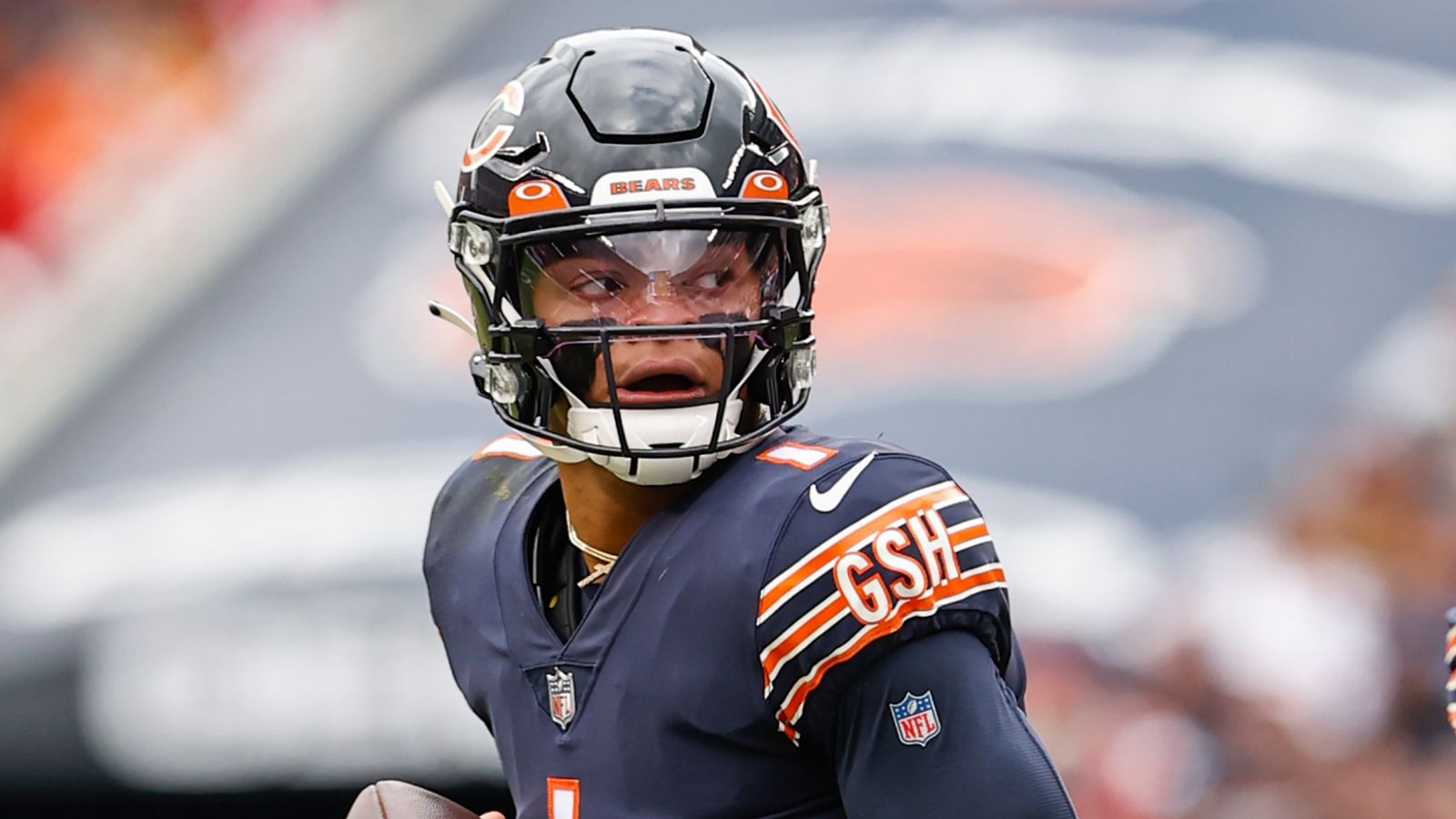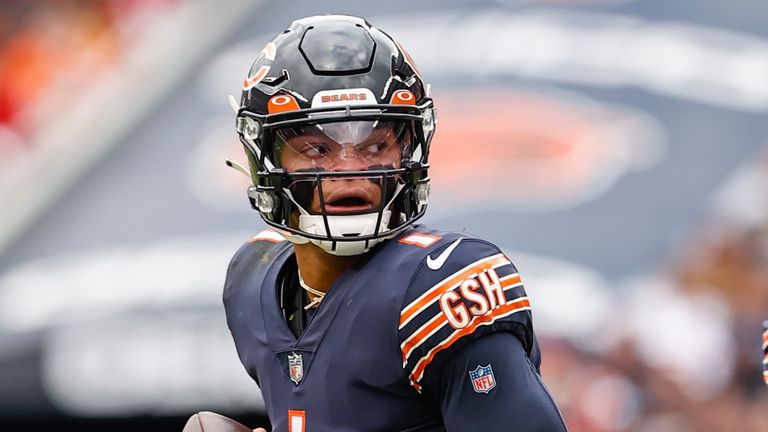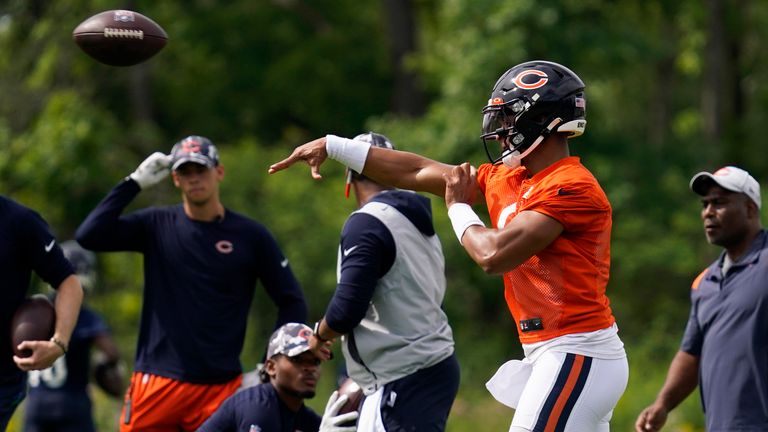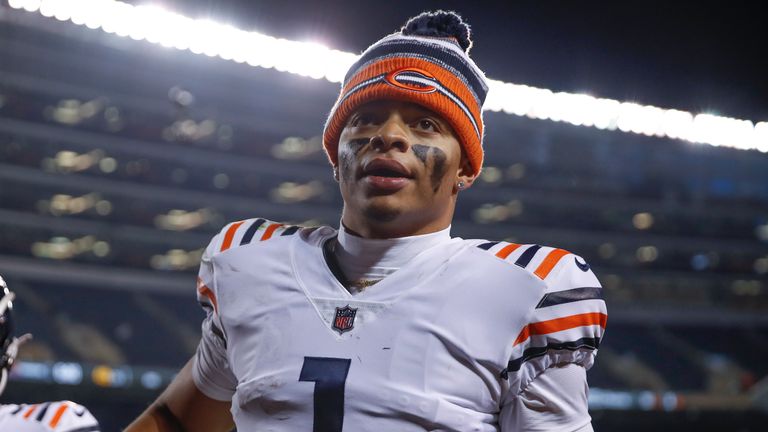

Will Justin Fields inspire a Bears resurgence?
Justin Fields pilots a Chicago Bears reset as one of the easiest stories to root for heading into his second season in the NFL.
Already he can attest to just about every shouty, rile-inciting critique customary to the league’s new generation of shiny quarterback; from the humdrum ‘struggles beyond the first read’ ignorance to which Patrick Mahomes can relate, to the ‘last guy in, first guy out’ fabrications quashed by Ryan Day coming out of Ohio State, to unsubstantiated Chinese whispers of leadership flaws from ever-chatty ‘anonymous sources’ refuted by Fields’ college team-mates.
He has shrugged off dented Draft stock built on the above as a once-consensus top-three pick who would eventually slip to 11th overall, he has a nine-sack game against the Cleveland Browns to epitomise/amplify a bruising hurdle-rich rookie campaign, and has seen young play-callers around him lavished with the purpose-built menu of new weapons and upgraded protection policies he may have been within his right to expect at Soldier Field this offseason.
But drip-fed among the final months of Matt Nagy and Bill Lazor’s spluttering offense arguably came as many glints of star potential as any fellow rookie quarterback. Poise in the face of trench chaos, maturity to temper tuck-and-run temptation, pocket-escaping heroics, hash-to-hash range and precision, poster-boy arm strength to fuel hopes of a Chicago resurgence.
The gyrating ‘defenders are lava’ absurdity behind his fourth-and-one touchdown run on a blown bootleg-turned-bob-and-weave clinic against the San Francisco 49ers was enough to win neutrals over – if his marauding run downfield to block for Trey Sermon in college against Michigan State had not already done so.
Now he gears up for year two with a box of mismatched jigsaw pieces and a Darnell Mooney-shaped edge piece with which to work around, albeit in addition to a Luke Getsy-scribed instruction manual that speaks Fields’ language with far more clarity and cohesion than that of the new Bears offensive coordinator’s predecessors.
The Fields-Mooney choreographed handshake-level connection was already brewing last season. There was the 64-yard sling-shot on a fly route as part of a 125-yard game against the Detroit Lions, orchestrated by Fields’ veteran-esque ability to delay the high safety from offering his cornerback assistance and Mooney’s explosive release-turned-daylight downfield; there was the unsung third-and-11 link-up for 22 yards against the Baltimore Ravens when Fields displayed tremendous pocket feel to slide up from pressure to his left before opening up his body and bypassing Travon Young with a laser to meet his receiver’s up-and-out at the sideline; there was the simple curl route to move the chains on first-and-15 against Green Bay, Fields fixing his eyes downfield to bait the tight end shallow crosser, the running back sneak and the field side smash concept before glancing left and firing low into a diving Mooney’s body to nullify touch coverage from Rasul Douglas.
Play-developing patience, pocket manipulation, flawless accuracy behind flailing arms and pristine timing.
Everything points to a WR1-calibre increase on Mooney’s 26.7 per cent target share in 2021. But elsewhere in life beyond Allen Robinson, who signed with the Los Angeles Rams in March, it has been every bit an audition process for trust and targets.
That Equanimeous St Brown’s scheme familiarity has been prevalent in training camp debriefs speaks to as much. The former Packers receiver is a willing seal blocker in a zone-heavy scheme, a polished route-runner at the break, a handy size-and-speed combination, and is well-tuned to the dink-and-dunk yards-after-catch role required in an age when an offense must stress its counterpart horizontally. But he also has just 16 catches for 215 yards and one touchdown over the last two seasons as a bit-part player at Lambeau Field. He has never been a top-three target in the NFL, let alone a top two. The ask? A hefty one.
Elsewhere on the depth chart fellow offseason addition Byron Pringle was arrested for reckless driving in April and has since sustained a quad injury, Dante Pettis has missed time through injury, former New England Patriots wideout N’Keal Harry faces a spell on the sidelines with a high ankle sprain and the Dazz Newsome package, as effective as it was at North Carolina, is still yet to be fully unveiled after a quiet rookie year.
Justin Fields 2021 stats
| Record as starter | Comp/Att | Passing yards | Passing TDs | Int | Rushing attempts | Rushing yards | Rushing TDs | Fumbles |
| 2-8 | 159/270 | 1,870 | 7 | 10 | 72 | 420 | 2 | 12 |
Third-round pick Velus Jones Jr teases a spark that could yet elevate the Bears offense alongside Fields and Mooney as an X, Y, Z rotator with the yards-after-catch electricity, second-effort speed to reward extended plays, instant separation upon release, mid-route physicality and balance to absorb contact while completing catches.
But it is another ask burdened by immediacy, piling on to Mooney expectations, reliance on a leap at tight end through Cole Kmet (60 catches, 612 yards in 2021) and defining production from a committee backfield. It makes for a less-than-clear path to sustainability for Fields.
As The Athletic reported, as Around the NFL’s Gregg Rosenthal relayed in dismay in a recent column, Fields was seen throwing to a receiver trio of Chris Finke, Nsimba Webster and Isaiah Coulter in training camp. Yikes.




Fields in action at training camp
One of the leading beacons of optimism has been new faces on the sideline. Amid division and caution over the appointment of a defensive-minded head coach in Matt Eberflus, Getsy entered the fold as former quarterbacks coach to a certain Aaron Rodgers in Green Bay and one of the newest West Coast branches who has been crafting his playbook as an NFL coordinator for an armoury like that of Fields.
With a complex formula comes simplicity in its commitment to accentuating all Fields is good at: Getsy arrives with the wide zone concept nuanced and personalised elsewhere by the league’s Kyle Shanahans, Sean McVays and Matt LaFleurs, brimming with the counter-flow play-action bootleg wrinkles capable of putting the former Buckeye’s explosive mobility, downfield aggression and off-platform zip centre stage.
Getsy, too, brings the wrinkles of an RPO-heavy offense fronted by Nick Fitzgerald while offensive coordinator to Joe Moorhead at Mississippi State in 2018.
It beckons as welcome change from a system that called designed roll-outs for Fields on just 19 occasions last season, per PFF. Nineteen. And such was the Andy Dalton-built approach that the Bears, meanwhile, ranked 31st in play-action pass attempts while finishing last with 594 yards off play-action throws, according to Sportradar.
The one-step cut-and-fly production of David Montgomery and Khalil Herbert in a masquerade wide zone world also holds a key role in keeping defenses honest amid the heightened inevitability of a Fields bootleg.
Expect more of the play action spin out-into-deep over throws tasked with liberating Fields and nullifying the influx of post-snap high-to-low safety rotation, alongside the delayed motion into full-back wham looks, the split backfield fakes that put linebackers in limbo. There is a thin line between slick subterfuge and an overkill of controlled chaos at the line of scrimmage, but a kinetic Bears offense of orbits and lateral funk is necessity in allowing Fields to thrive.
Scheme may dictate that Jones thrives in that respect such is the Tennessee product’s potential to aid field scheme diagnosis as a jet sweep or bubble-screen threat.
A first-and-goal scenario against the Los Angeles Rams on the opening day of the season hinted towards what could have been a familiar component on offense: the Bears were lined up in split backfield, Kmet motioning from running back to full-back before darting out in a power run look while Damiere Byrd swept in the opposite direction to sell the read defender, thereby giving Fields the green light for an easy keeper behind Kmet’s block into the end zone. A mere flicker of that kinetic offense, that lateral funk.
A popular feature to Bears training camp has been work in the ‘I’ formation Nagy was seemingly less than fond of, teasing another avenue to combatting read-fogging post-snap shifting, as well as a full-back revival in Chicago and an impetus towards demanding run respect as a means of carving open the Fields deep shot.
That premise is backed up by Fields logging an NFL-high 90.5 passing grade when outside of the pocket of his last five starts in 2021 (PFF). Granted, there has to be something for that arm to throw to.




“You get in that film room, and you can see the hunger, you can see the fight. That’s part of our job is to make sure he has clarity through all that. He has that competitive edge that you need to play in this league, especially at this position.”
Bears OC Getsy on Justin Fields, per the Bears official site
Efforts to plant Fields in the pocket were not totally malign thanks to flashes of his IQ and intermediate-to-deep accuracy, but they were often flawed by predictable concepts or shoddy protection. As much was underlined on occasions when the Bears turned to empty quads formations to take on quarters coverage, pressure on Fields to get the ball out quickly not aided by a crumbling offensive line.
Negligence up front became a damning theme to his bed-in period, even Fields’ elusive expertise unable to swerve 36 sacks and 30 hits in 12 games in addition to pressure on 42.8 per cent of drop backs.
The problems continued come training camp, the obscure absence of second-year offensive tackle Teven Jenkins and accompanying trade speculation casting doubt over his future while contributing to Getsy-admitted uncertainty over the Bears’ first-choice offensive line. That sub-plot currently leaves fifth-round rookie Braxton Jones as the likely starting at left tackle.
What’s more, projected starting center Lucas Patrick has been nursing a hand injury keeping him sidelined in practice. Sam Mustipher and Doug Kramer have been working there in his place, Riley Reiff has been shifted to right tackle and Michael Schofield has been sharing reps at right guard with Ja’Tyre Carter. The rotation may yet continue into Week One, the Bears not only still seeking to decipher their strongest combination but priming them for the lateral athleticism fundamental to a wide zone scheme.
On the other side of the ball, star linebacker Roquan Smith requested a trade based on the belief the Bears front office ‘does not value’ him. Which is not ideal, or reflective of harmony.




“It’s in Justin Fields’ hands, period. He can do this. I love the offense he’s in. Luke Getsy is a rising star in this business. I think he’s in a really, really good position.”
NBC’s Peter King following his visit to Bears training camp
Back to Fields, life under Getsy also promises more designed runs for a drive-flipping ball-carrier that saw scrambles amount to much of his 420 yards on the ground last season. Funnily enough, Mooney admitted in training camp that the Bears barely practised scrambling with Nagy and Lazor the previous year. Curious.
With self-assurance over his outer-pocket mobility came a maturity in his decision to give plays the opportunity to materialise as opposed to merely taking off, even when that might have been the wise call to make. It is a split-second balance of decisions that will no doubt slow down for him in a system to which he is better suited.
It should be noted Fields was not perfect – why would he be in year one? Ball security was an area that needed work, his drop back and pocket manipulation footwork emerged as a focus point heading into the offseason, his anticipation looked like it would improve with consistent play-calling and reps, the disguise of designed runs were bound to become more wily in appearance, the trigger could have been pulled quicker at times and there were plain old rookie miscues. He knew as much.
But beneath issues around him, film encouraged and, at times, enamoured. Wide zone success was previewed against the 49ers through the bootleg dart to Jesse James for a touchdown, and a near-identical play to collaborate with the tight end on a deep over, while a bullet to beat the hook/curl defender flashed anticipation on the kind of basic slant that should have been called more regularly.
Among his brightest outings came a 291-yard game against a rampant Pittsburgh Steelers defense: one play saw him maintain composure to set his feet on a wide zone bootleg about to be blown up by TJ Watt, before locating Kmet outside the numbers on a deep over for the first down; another read-option scenario on second-and-eight saw him freeze the high safety with his eyes before splitting the linebacker and lurking safety to locate Jimmy Graham up the seam.
In a land of quarterback spies he is your ‘catch me if you can’ outlet, in an era of post-snap rotation he is your poised processor, in a wide zone craze he is your bootleg-and-bludgeon arm-contortionist, and he has a haymaker in the locker for good measure.
He has had it as tough as any, and will likely continue to do so. You just hope he gets the chance to be what all at Ohio State will tell you he can be.